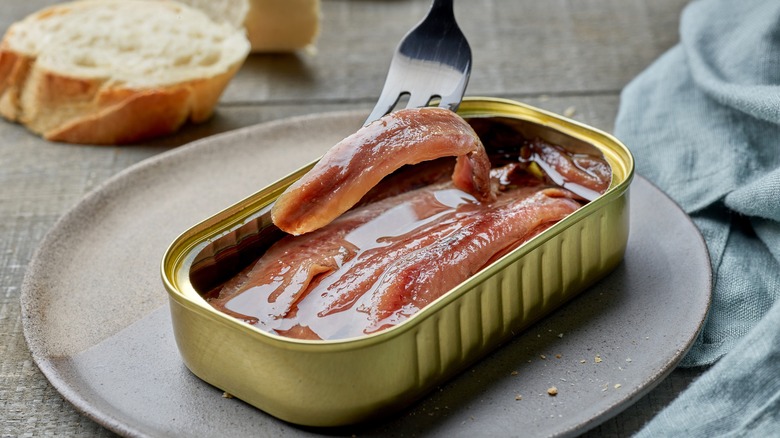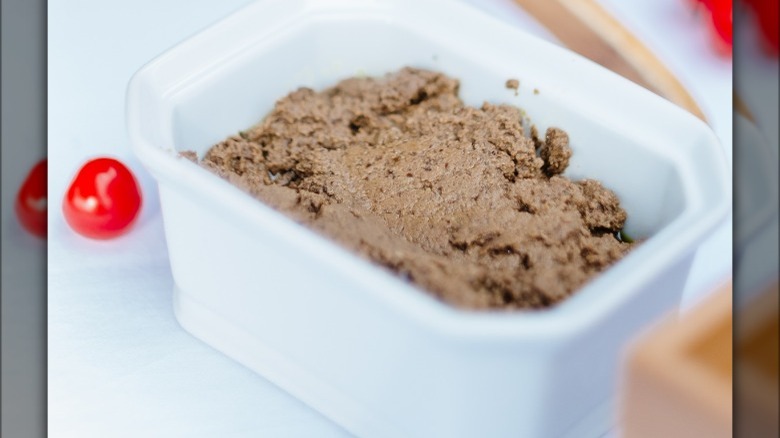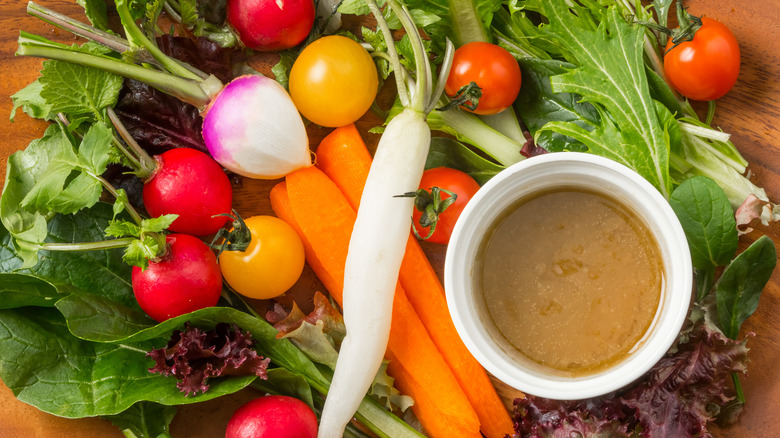The French Anchovy Dip That Achieves A Full Flavor With Few Ingredients
Admit it, anchovies get a bad rep, and much of this reputation has to do with looks and packaging. According to Paesana, anchovies are cured and packed into containers filled with salt for several months. The resulting hue these little fishy filets take on is that of a reddish brown, colors which, in and of themselves, may not be wholly unappetizing. The stigma that has unfairly been placed on anchovies tends to give people pause when seeing a recipe in which they are the main ingredient. However, if you give them a try, you may just find yourself rethinking your position on anchovies.
It's called anchoïade and it's from the Southern French region of Provence. Anchoïade, along with its cousin, the olive concoction known as tapenade, are staples of Provençal cuisine. According to Smithsonian Magazine, the Mediterranean Sea, particularly the area between Catalonia, Spain and Collioure, France, has been fished for anchovies since the days of the Ancient Greeks. All of Provence's coast, the Côte d'Azur, is along the Mediterranean (per Britannica). So it stands to reason that once caught and cured, the French would take their food-loving proclivities and apply them to this salty little fish.
From the depths of history
In a November 2021 article, Smithsonian Magazine reports that food detectives were hunting for an ancient Roman condiment. Archaeologists excavated enormous concrete vats in France and Tunisia believed to have contained a fermented fish sauce known as garum. While there was no organic matter left in these vats to analyze, garum is believed to have had a basic combination of fermented anchovies and salt.
Though popular in ancient Greece, Garum is most connected with Roman culture. 196 Flavors explains that the Roman food lover Apicius wrote no less than 25 recipes in which garum was used as a flavor enhancer. And due to the breadth of the Roman Empire, this fish sauce was adapted into numerous variations, depending on the region. This is the history anchoïade is believed to be descended from; a variation of an ancient Roman side dish, now with a French twist.
Making traditional anchoïade
So what is the base of the traditional Provençal anchoïade? According to TasteAtlas, it's really just four ingredients which are anchovies, red wine vinegar, garlic, and olive oil. To start, either using a mortar and pestle or a simple food processor, grind the garlic and anchovies into a paste. There is absolutely no need to add salt to this. Once the fish and garlic are decently combined, whisk in the olive oil and vinegar until you reach a consistency that is like soft butter. Anchoïade should easily slather over a piece of toast or be simple to dip into with a vegetable.
The flavor of anchoïade is akin to that of an umami bomb. America's Test Kitchen goes so far as to call it an Umami Overload Dip for those who are anchovy averse. Umami is the fifth taste along with bitter, sweet, salty, and sour (per WebMD). It is translated from Japanese as "savoriness," which is a perfect, albeit simple, way of describing anchoïade. Our own recipe adds lemon juice, red pepper flakes, and parsley and involves heating the anchovies and garlic until the anchovies have broken down enough to form a warm paste.
Numerous variations
Though our main focus here is the anchoïade of Provence, it is worth noting that there are several variations of this dip throughout several European nations. One of the closest relatives comes from the neighboring Italian region of Piedmont. Banga cauda — hot bath in Italian — is a fondue-like dip of olive oil, anchovies, and garlic typically served around Christmastime (via Epicurious). It is intentionally served warm as an appetizer with fresh vegetables or bread.
Within Provence itself there are several variations of the traditional anchoïade. While the base of anchoïade consisting of anchovies, garlic, vinegar, and olive oil remains the same, additional ingredients are often added to adapt the dip's flavor for specific tastes. America's Test Kitchen adds blanched almonds for a sweeter, less pungent anchoïade. Another variation, known as anchoïade nicoise, adds chopped olives in with the anchovies and garlic. According to Delighted Cooking, the addition of the olives makes the mixture resemble a "spicy tapenade."
How to eat and enjoy anchoïade
In France, there is a part of food culture known as an aperitif. As Thrillist explains, the aperitif is a way of drinking, of enjoying a glass of wine and some light bites to prepare your palate and your wit before the proper start of the meal. Anchoïade is perfect for this.
This garlicky dip is meant to serve as the aperitif centerpiece of your Provence-inspired dinner party. Anchoïade can be served slathered on toasted bread (crouton) or with an assortment of vegetables. Jessica B. Harris, writing for TODAY, likes to pair her anchoïade with a collection of raw or blanched veggies like snow peas, new potatoes, blanched broccoli, and cauliflower. The vegetables offer sweet, refreshing flavors that cut against the sharpness of the anchoïade. Harris also recommends drizzling anchoïade on grilled chicken or steak as a great flavor punch or salt substitute.
You simply cannot do aperitif without a glass of wine. And what better to pair with this lovely dip than a Provencal rosé? Matching Food and Wine says that a dry rosé pairs perfectly with anchoïade. A crisp, chilly rose cleanses the palate and offers a reprieve from the dip's saltiness. There are countless ways you could experiment with this simple dip, from the ingredients you add to the veggies you pair it with. So, if you can get past the anchovies, you'll be on your way to enjoying this delectable, savory treat.




